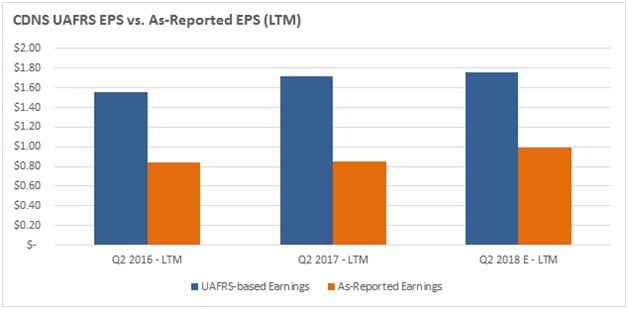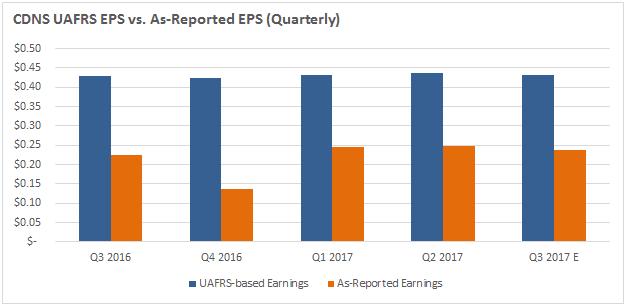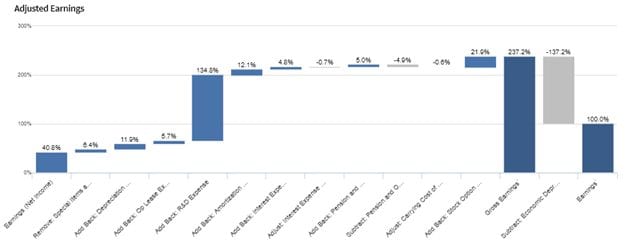CDNS’ Uniform Adjusted EPS’ is greater than as-reported earnings suggest, and projected to continue to grow, implying valuations may be too low
- CDNS’ profitability is materially distorted by accounting for R&D and stock option expense
- As such, their UAFRS EPS’ was $0.44 in Q2 and $1.72 in the last year, not $0.25 and $0.86, respectively, as GAAP accounting metrics report
- At current valuations, markets are embedding expectations for 6% annual EPS’ growth, which is slightly lower than adjusted estimates for 8-10% growth going forward, warranting equity upside should the firm just meet estimates
Cadence Design Systems (CDNS) released Q2 2017 earnings on 7/24, beating estimates on both the top and bottom line. EPS came in at $0.25 for the quarter, with EPS excluding stock-based compensation coming in at $0.34, beating by $0.02, and revenues beating by $2.83m. Since the bullish announcement, shares have rallied over 11%, as investors have been attracted by the firm’s solid earnings and substantial growth prospects.
Additionally, after making the appropriate adjustments under Uniform Adjusted Financial Reporting Standards (UAFRS), it is apparent that profitability is even greater than traditional EPS implies, and is projected to continue to grow substantially going forward, suggesting the potential for the recent rally to continue.
Specifically, under UAFRS, Uniform EPS (EPS’) actually reached $0.44 in Q2, more than 75% higher than GAAP EPS. Additionally, over the last four quarters EPS’ has been $1.72, exactly 2x as-reported EPS of just $0.86 in the same timeframe. Given EPS’ that is greater than reported, and continued growth potential, CDNS valuations may be too cheap, even after the recent rally.
The quarterly results show a similar trend, with EPS’ expected to remain well above as-reported EPS going forward, as it has in each of the last four quarters. As such, should EPS’ continue to meet growth projections, valuations may be too low.
UAFRS, Uniform Adjusted Financial Reporting Standards, call for removal of distortions from issues like the treatment of R&D and stock option expense. Once removed, it is apparent that CDNS’ profitability is greater than as-reported metrics suggest, warranting further upside at current levels.
UAFRS vs. As-Reported EPS
Investors make major decisions about which companies to own based on quarterly company earnings, the most common metric mentioned in traditional corporate investment analysis.
However, more often than not, the earnings that companies report in any given quarter can swing wildly and lead investors to completely wrong conclusions, because GAAP and IFRS rules force management to report results in ways that are not representative of the real operating performance of the business.
While there is a case to be made that some management teams can use “creative accounting” to adjust numbers, the research would show that more often than not, the real problem is with the accounting rules themselves, not management’s use of them.
The UAFRS Advisory Council has identified over 130 accounting and financial reporting inconsistencies (some of which can be found here), of which several have material impact on CDNS’ financials.
Impact of Adjustments from GAAP to UAFRS
Two key UAFRS adjustments have the largest impact on CDNS’s income statement, to get from earnings to UAFRS-adjusted earnings. These are related to R&D and stock option expense.
GAAP and to a lesser extent IFRS (which allows for capitalization of a portion of R&D expense) treat R&D investments as expenses, when in actuality these are investments in a company’s future operations. They may be good investments or bad investments, but it’s hard to think of R&D as cost of goods sold.
In the case of R&D expense, this is often a multi-year investment in a firm’s future offerings. Expensing R&D violates the basic matching rule of accounting, that expenses should be recognized in the period the related revenue is recognized.
Expensing R&D can also dramatically increase earnings volatility, as the timing of R&D related to multi-year projects can create lumpy earnings volatility, distorting understanding of a company’s real profitability.
Additionally, CDNS has had material non-cash stock option expense since the company was founded. This is treated as an expense to the company in accounting statements, when it is actually a way for the company to give employees an ownership stake in the company. As such, this non-cash expense should be treated as dilution to equity holders and another claim against the Enterprise Value of the firm, as opposed to it being treated as an annual expense. This is especially true as, unless the company uses cash to buy shares (to suppress dilution for equity holders from the option grants being exercised), there is no cash impact on the company.
UAFRS-reporting adjusts for these traditional accounting distortions by treating all R&D as investing cash flows and re-bucketing stock option expense into enterprise value. These simple reclassifications remove a tremendous amount of accounting noise related to investment activities and improve investors understanding of the operating earnings of a business.
Greater-than-reported EPS’ and expectations for growth suggest valuations may be too low
At current prices, CDNS is trading at a 26.2x traditional forward P/E, which is in line with peers with similar growth prospects, and would appear to indicate a fairly valued firm. However, after making the requisite adjustments, it is apparent that the firm is actually trading at a UAFRS-based P/E of 21.2x, which is actually at a discount to peers with similar growth prospects.
Specifically, at a 21.2x UAFRS-based P/E, markets are embedding expectations for annual EPS’ growth of 6%, which is slightly lower than long-term adjusted estimates for 8%-10% annual EPS’ growth. As such, should CDNS simply maintain growth in-line with analyst estimates, equity upside would be warranted, and should the firm continue to beat expectations, this upside could be material.
By using Uniform Adjusted Financial Reporting Standards (UAFRS), investors see a cleaner picture that distorted GAAP and IFRS metrics cannot show. By standardizing financial reporting consistently across time and across companies, corporate performance and valuation metrics improve dramatically. Comparability of a company’s earnings over time, trends in corporate profitability and comparability in earnings power and earnings growth across close competitors and different sectors becomes far more relevant and reliable.
To find out more about Cadence Design Systems, and how their performance and market expectations compare to peers, click here to access the open beta of the Valens Research database.
Our Chief Investment Strategist, Joel Litman, chairs the Valens Research Committee, which is responsible for this article. Professor Litman is regarded globally for his expertise in financial statement analysis, fundamental research, and particularly Uniform Accounting, UAFRS.







